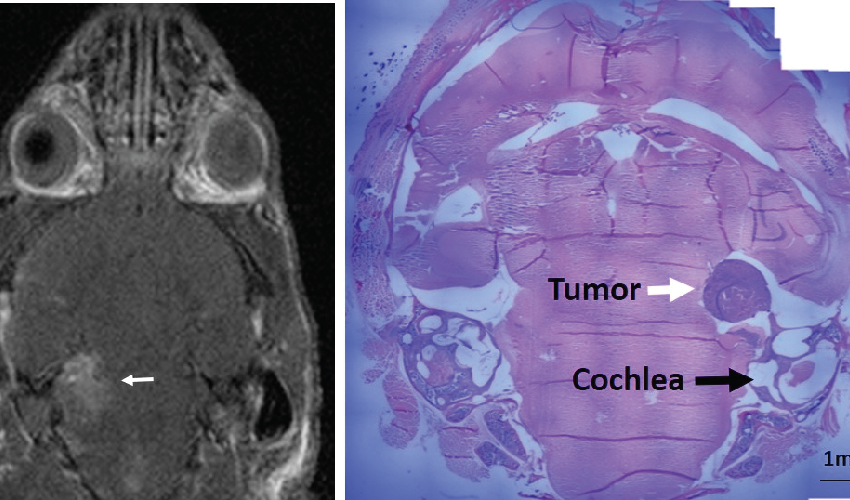Cerebellopontine Angle (CPA) Model
Author: Lei Xu, M.D., Ph.D., Massachusetts General Hospital
Published On: 05/15/2019

 Neurofibromatosis type II (NF2) is a disorder that is typically inherited and characterized by bilateral vestibular schwannomas (VSs), which are benign nervous system tumors composed of neoplastic Schwann cells. VSs cause progressive hearing loss, which often leads to increased social isolation and higher rates of depression, and in some cases, dizziness, facial paralysis, other neuropathies of the cranium, and even mortality. Currently, approved VS and NF2 therapies include surgery and radiation. However, both are accompanied with tremendous risks of worsening existing hearing loss and increasing tumor resistance as a result of further radiation. Bevacizumab has shown promise in VS growth reduction and improved hearing in patients with progressive VSs; however, the hearing improvements are not durable, and issues of tolerability as a result of side effects associated with long-term use remain a challenge. There is an unmet need for NF2 therapies with enhanced efficacy and limited toxicity-associated VS hearing loss. A better understanding of VS progression and hearing loss is essential, but is limited by the lack of animal models for studying the molecular mechanisms and biology of NF2 tumor progression or the manner in which it affects neurological function.
Neurofibromatosis type II (NF2) is a disorder that is typically inherited and characterized by bilateral vestibular schwannomas (VSs), which are benign nervous system tumors composed of neoplastic Schwann cells. VSs cause progressive hearing loss, which often leads to increased social isolation and higher rates of depression, and in some cases, dizziness, facial paralysis, other neuropathies of the cranium, and even mortality. Currently, approved VS and NF2 therapies include surgery and radiation. However, both are accompanied with tremendous risks of worsening existing hearing loss and increasing tumor resistance as a result of further radiation. Bevacizumab has shown promise in VS growth reduction and improved hearing in patients with progressive VSs; however, the hearing improvements are not durable, and issues of tolerability as a result of side effects associated with long-term use remain a challenge. There is an unmet need for NF2 therapies with enhanced efficacy and limited toxicity-associated VS hearing loss. A better understanding of VS progression and hearing loss is essential, but is limited by the lack of animal models for studying the molecular mechanisms and biology of NF2 tumor progression or the manner in which it affects neurological function.
With support from a Fiscal Year 2015 New Investigator Award (NIA) through the Neurofibromatosis Research Program, Dr. Lei Xu and her team are utilizing animal models to evaluate the potential of immunotherapy in controlling tumor progression for enhanced survival. Dr. Xu aims to determine whether the combination of immunotherapy with anti-vascular endothelial growth factor (anti-VEGF) can enhance the delivery of immune checkpoint inhibitors and facilitate activation of immune effector cells for improved treatment efficacy. Preliminary data from Dr. Xu’s group confirms the presence of immune checkpoint molecules in NF2 schwannomas and demonstrates that NF2 patients are in an immune suppressive state. The group has also previously shown that anti-VEGF treatment, via normalizing the abnormal schwannoma vasculature, improves perfusion, reduces tumor hypoxia and significantly enhances radiation efficacy.
Dr. Xu and her team recently published a protocol [1] on their newly developed cerebellopontine angle (CPA) model for the in vivo study of NF2-related VSs pathophysiology and neurological function. The protocol describes a technique for delivering schwannoma cells into the mouse brain CPA region. This technique opens several avenues for investigating tumor biology, hearing, and neurological function in VSs. The group describes applications of state-of-the-art intravital imaging and hearing assessment techniques for the study of tumor growth and hearing loss. This animal model is a powerful tool in facilitating the study of VS pathobiology through several perspectives, including tumor progression, hearing and neurological function, and facilitates testing the efficacy of novel therapeutics.
Read more here.
Want to view archived newsletters? Click Here!
Newsletter
Sign up to receive the latest neurofibromatosis news and information in your inbox!
Subscribe